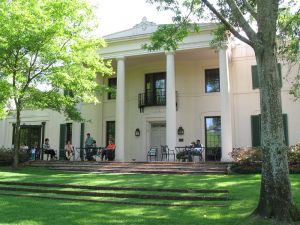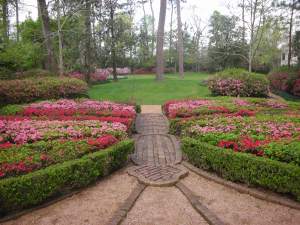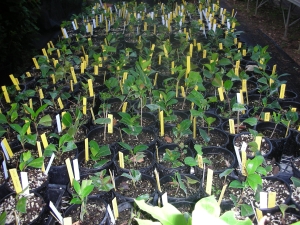As part of my degree, I recently performed an internship at Bayou Bend. If you are not familiar with Houston’s hidden gem, then read on! Bayou Bend is a treat for all lovers of history and gardens. And … since it is an all organic garden, it should be of interest to those of us who are interested in more than just growing. Hope you enjoy it!
History – The Bayou Bend Collection and Gardens is the home to the Museum of Fine Arts Houston’s collection of decorative antiques. The home houses one of the best collection of American antiques in the world. The grounds consist of 14 landscaped acres that contain eight separate gardens.

The back terrace of Bayou Bend
Miss Hogg was the heir of an oil operation that eventually became Texaco. She used her family fortune for many philanthropic purposes. In addition to Bayou Bend, her family legacy includes Memorial Park, River Oaks, The Houston Symphony and the Museum of Fine Arts. She was also instrumental in preserving Texas history and the culture as evidenced by her preservation of many early Texas buildings at Warrenton, Texas. In addition to these civic pursuits, Miss Hogg was a champion for mental health facilities and equal education opportunities for minorities.
The Hogg mansion was built between 1927 and 1928. At the time the house was built the property was “nothing but a big thicket”. Miss Hogg was an avid gardener and nature lover. Her vision from the beginning was to ensure that the property remain mostly a native lower coastal forest. Only one tree was removed during the building of the house. Over the next several years Miss Hogg created eight separate and unique gardens on the property. Three of the gardens are named for mythological goddesses or muses (Clio, Diana and Euterpe).

The Clio garden after a spring flood in 2008
The other gardens are the White, East, Butterfly and Carla. The final garden is the manicured native woodscape. Miss Hogg donated her home and gardens to the Museum Of Fine Arts Houston in 1957. They were opened to the public in 1966.
The gardens of Bayou Bend are now under the direction of a true Master of Horticulture, Bart Brechter (B.S. Horticulture, Stephen F. Austin State University), Curator of Gardens. Mr. Brechter is tasked with maintaining these gardens in accordance with the original plans drawn out by Miss Hogg. He uses only plant materials that were planted during Miss Hogg’s lifetime. The main feature of this garden is the azalea collection. Bayou Bend is home to one of the most complete collections of Southern Indica azalea’s in America. He uses 100% natural methods for maintenance, fertilization and pest control. He is also responsible for a large collection of trees. The River Oaks Garden club pays for all of the tree maintenance at Bayou Bend. Mr. Brechter has also been able to establish a dogwood on the property as a new cultivar, Cornus florida, “Bayou Bend”. He is in the process of propagating cuttings from this tree. Sale of these cuttings will go toward the up keep of Bayou Bend.
 Plant Propagation – Due to its charter, the Bayou Bend gardens are allowed to only use plant materials that were in the garden during Miss Hogg’s lifetime. Many of the azaleas and other plants are “antique”. This means that they are older varieties that have fallen out of favor with the nursery trade. Because of this, Mr. Brechter acquires much of his plant material through propagation. To aid in this he manages a greenhouse on site that he shares with the River Oaks Garden club. On my first visit to Bayou Bend, Mr. Brechter had me repot 52 varieties of camellias. These cutting were in large flats filled with a 100% Perlite mixture. They had been in the greenhouse since last November. My first step in the propagation process was to create the potting mix. I used a 1-1-1 mixture of Perlite, commercial potting mix and composted hardwood mulch. Once the mix was ready I used it to fill quart containers. I would then gently remove the cuttings from the Perlite tray and evaluate for rooting. If the cutting showed root development it was repotted in the quart container. Once a tray was filled with the one gallon pots, the tray was moved outside to the shade cover area in the greenhouse compound and watered.
Plant Propagation – Due to its charter, the Bayou Bend gardens are allowed to only use plant materials that were in the garden during Miss Hogg’s lifetime. Many of the azaleas and other plants are “antique”. This means that they are older varieties that have fallen out of favor with the nursery trade. Because of this, Mr. Brechter acquires much of his plant material through propagation. To aid in this he manages a greenhouse on site that he shares with the River Oaks Garden club. On my first visit to Bayou Bend, Mr. Brechter had me repot 52 varieties of camellias. These cutting were in large flats filled with a 100% Perlite mixture. They had been in the greenhouse since last November. My first step in the propagation process was to create the potting mix. I used a 1-1-1 mixture of Perlite, commercial potting mix and composted hardwood mulch. Once the mix was ready I used it to fill quart containers. I would then gently remove the cuttings from the Perlite tray and evaluate for rooting. If the cutting showed root development it was repotted in the quart container. Once a tray was filled with the one gallon pots, the tray was moved outside to the shade cover area in the greenhouse compound and watered.

Camellia cuttings that I potted during my intership
On my second visit, Mr. Brechter had returned from a meeting of the Texas Azalea Society in Nacogdoches, Texas. While on this trip, he took cuttings from 31 varieties of hollies from the SFASU Mast Arboretum. These cutting were wrapped in wet newspaper stored in zip lock baggies in a refrigerator. We filled large trays with Perlite and began to disassemble the cuttings. Before planting, we treated all of the plants for pests by immersing them in a mild solution of water and orange oil. Once treated, I cut the stems at a 45 degree angle on a node. I stripped all but three or four leaves from these cuttings and then inserted them into the Perlite. Once a tray was filled and labeled, the tray was placed under the mister.
Grounds Maintenance – Bayou Bend is essentially a 14 acre public garden. The site contains large swaths of St. Augustine turf and many formal and informal landscape areas. Much of the grounds are planted in perennials. The bulk of these plantings are the azaleas for which Bayou Bend is famous. These azaleas make Bayou Bend spectacular in the spring and it is the anchor of the annual River Oaks Garden Club’s annual Azalea Trail. There are also many beds that are planted with annual color. Mr. Brechter buys many of these annuals from specialized growers that provide him access to many of the antique varieties of plants he requires. In spring, Mr. Brechter uses a purple pansy that is currently only available from one nursery. Another spectacular example of annual plantings is the beds at the front of the house. As you approach the house from Lazy Lane Boulevard, the shaded drive opens to a circular driveway. Where the drive meets the driveway are two large beds that are bordered with mondo. Each spring, these beds are filled with over 10,000 tulips. The tulips are then followed with 5000 pink caladium bulbs (Carolynn Wharton) which are removed and stored at the end of the season as well. All of these plantings are maintained with natural methods.

Begonnias on the East Terrace
Bayou Bend’s many perennials are planted in beds that have been worked with compost and mulch for years. This soil provides excellent drainage and nutrients for the plants and aids in water conservation. The perennials receive minimal pruning. All plantings receive a deep layer of hardwood mulch every year. This mulch is allowed to decompose and provide addition organic matter to the soil. Tender annuals receive a soil and foliar application of Bio Matrix. All weeding is done by hand.
Pesticides/Fungicides – Mr. Brechter only applies pesticides on an as needed basis. The garden is relatively pest free. Mr. Brechter attributes this to an abundance of plant materials that are naturally resistant to most of the insects and fungus that are found in gulf south. Also, the organic methods used attract beneficial insects, animals and birds which in turn help keep down the pest problems. When an insect outbreak is spotted (this happens most often in the greenhouse area), Mr. Brechter sprays the infested plants with an Orange oil solution. Orange oil is effective on aphids, mites, lacewing and other common nursery pests.
Earth-Kind – When this directed studies program was approved, I was supposed to help Mr. Brechter start an Earth-Kind certification trial for azaleas. During my first two visits, we began work on the trial. Mr. Brechter had worked with Texas A&M Extension to establish the parameters of the test. It was determined that we would plant three plants of five varieties in a bed of about 1000 sq’. The azaleas were to be planted in unimproved soil on 6’ centers. Irrigation was to be supplied by a drip system that connected to a pop up heads in the existing irrigation system. The plants were to be monitored for three years. During that time they would be provided with minimal feeding, pruning and pest control. Over the course of the next three weeks, we picked a site and cleared it. We manually removed all vegetation from the area with grubbing hoes. The ground was lightly broken and then raked smooth. We then laid out the plant spacing. Once this was done, we selected the azalea varieties to be used. For this trial we planned to use 1 Encore variety-Autumn Embers, 3 Southern Indica varieties: Formosa, G.G. Gerbing and George tabor and 1 Kurume variety called Fashion.
On week three, we were going to install the irrigation and the plants. However, Mr. Brechter was asked to hold off on this trial. He was informed that the Earth-Kind program was under going revisions and A&M would prefer he wait. Because of this we were not able to begin the experiment.













